 Guided missile Frigates 1976-2022:
Guided missile Frigates 1976-2022:FS Georges Leygues, Dupleix, Montcalm, Jean de Vienne, Primauguet, La Motte-Picquet, Latouche-Tréville D-640-646
Cold war French Navy:
FS Jean BartFS Arromanches | Bois Belleau class | Clemenceau class | FS Jeanne d'Arc | PA 28 | PH 75 | FS Charles de Gaulle | 2030 PANG
Chateaurenault class | FS De Grasse | FS Colbert
Surcouf class | Duperré class | La Galissonière | Suffren class | Tourville class | Georges Leygues class | Aconit | Cassard Class | Lafayette class | Forbin class | Aquitaine class
La Creole class | Narval class | Arethuse class | Daphne class | Gymnote | Le Redoutable class | Agosta class | Rubis class | Amethyste class | Le Triomphant class
Le Corse class (1952) | Le Normand class (1954) | Cdt Riviere class (1958) | Estiennes D’Orves class (1973) | Floreal class (1990)
Issole | EDIC class | Trieux class | Ouragan class | Champlain class | Bougainville | Foudre class | CDIC class | Mistral class
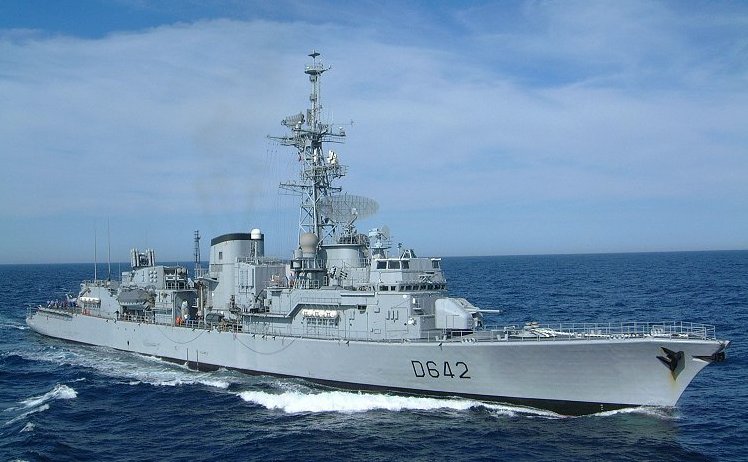
The Georges Leygues class (Type F70 AS) were anti-submarine multi-role destroyers having Exocet and Crotale missiles among others for multiple missions of strategic locations, show the flag, escort a task force, and evolved from a simple ASW corvette designated C70 (hence the “C”), but the scale of the programme and of each ship had them re-rated and internationally labelled an “anti-submarine destroyer” so “D” was used in their hull numbers and ended designated as “frigates”, final programme designation F70. Seven ships were built, bearing famous names of past cruisers, in service from 1979 to 2022 for the last decommissioned, Latouche-Tréville. They served in both fleets, Toulon (Mediterranean) and Atlantic (Brest) and proved just as vital for the last cold war French Navy as the Kortenaer were for the Netherlands Navy. #coldwar #exocet #frigate #aswfrigate #marinenationale #frenchnavy
Development
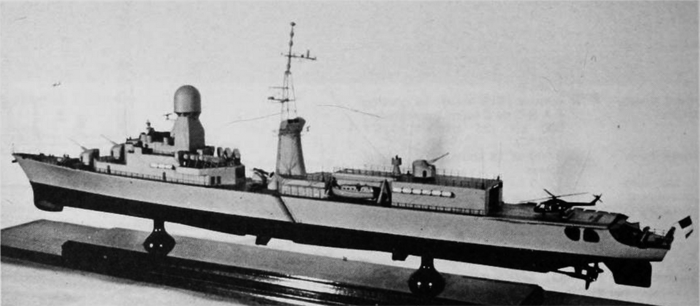
The previous Tourville model, concept, 1970. The G. Leygues were “destroyers” (a catch all definition mirrored by Jane’s own classification) in all but name, seen as an in-between the smaller Cdt. Riviere and Tourville.
In 1962-1963, the French Navy accepted nine 2,170-ton Commandant Rivière class “avisos-escorteurs”, classed as corvettes expected to be decommissioned until the 1990s. These wre seen as a cheaper alternative to the past large frigates designed until the, the Suffren (AA) and Tourville (ASW) and make it for numbers. They were seen as transitional vessels as at the same time were designed larger corvettes in a programm that would besom the the Georges Leygues class. In betwee, Aconit (F65), a 3,875 tonnes ASW frigate attempt entered service in 1970, showing a notpromising design.
 The Georges Leygues class Corvettes (C70 or “Corvette FY1970”) were at first conveived in 1964 as a larger version of the Aconit, with two propellers and an helicopter deck, but this in 1968-69 this was changed to a fully fledge Frigate design to reflect all the changes in design. The introduction of the French-British designed ASW Lynx helicopter indeed changed the game for the French Navy, which had access to a far better option than the older, 1st generation Alouette III helicopters, more suited for SAR than any ASW work.
The Georges Leygues class Corvettes (C70 or “Corvette FY1970”) were at first conveived in 1964 as a larger version of the Aconit, with two propellers and an helicopter deck, but this in 1968-69 this was changed to a fully fledge Frigate design to reflect all the changes in design. The introduction of the French-British designed ASW Lynx helicopter indeed changed the game for the French Navy, which had access to a far better option than the older, 1st generation Alouette III helicopters, more suited for SAR than any ASW work.
“A ship alone facing a submarine has no chance. It is the duality between the helicopter and the frigate which allows us to have at least equality, if not the advantage”
Captain Luc-Marie Lefebvre (Montcalm).
Thus, the class was designed in the end as an intermediate surface ASW asset between the larger, task force escort Tourville class frigates and the nine smaller Estienne d’Orves class Frigates (“aviso” in French parlance, meaning despatch vessel). In the wake of 1968 Plan Bleu, the General Staff wanted to deploy eight ASW ships, five in Brest, to clear the way for SSBNs into the Atlantic (Strategic Oceanic Force “FOST” in Long Island Naval Base, Brest) and three more to be based in Toulon and protect the on-board naval aviation group of the carriers Foch and Clemenceau. The fina design was ready in 1973 and total was to be voted that year, for a first ordered in 1974.
There was first batch of three in December 1974 and 1975, and budgetary issues after the 1973 crisis started to delay the program. 1976-78 budgetary years were skipped, and the next batch was maintained to four ships, but ordered and laid down in 1979-1984. These ships will serve for more than three decades, modernized top to bottom (see later).
Design of the class
Hull and general design
The G.Leygues class design was based on a relatively light 3,550 t (3,494 long tons) and 4,500 t (4,429 long tons), smaller than the Tourville-Suffren but much larger than the Aconit. Full load displacement at the end of their career after all modernization and addons, they ended at 4,830t tonnes fully loaded, 300 tonnes heavier than initially planned, leading to some stability issues.
The hull was in straight line to other design with a caracteristic “broken prow”, the clipper bow having a short flat section which then sloped down to the main weather deck level. This was not a pure flush deck as the hull had a break at the stern to operate the large towed VDS apparatus. The helideck was placed just before it, and the large hangar afterward.
The hull measured 139 m (456 ft) overall for a beam of 14 m (45 ft 11 in) and draught of 5.7 m (18 ft 8 in) so it had a favourable ratio for speed at 1/10, but they were concerns about stability from the start, notably with the lighter COGOG powerplant. Engineers worked out how to reduce the superstructure weight with aluminium alloys notably, while taking in consideration fire proof measures.
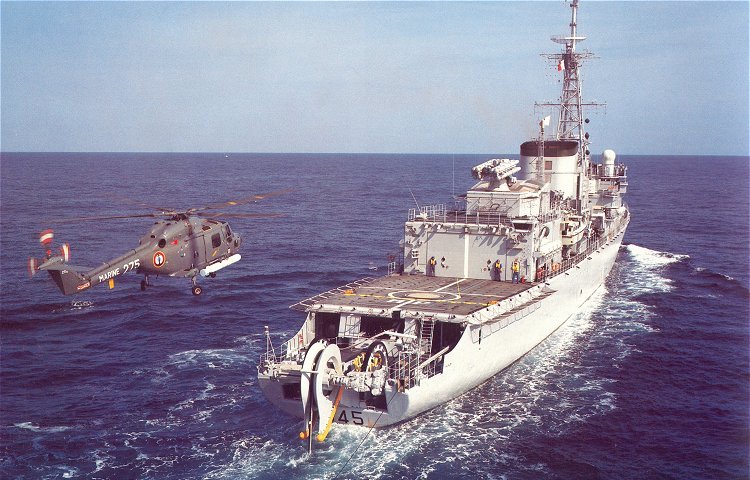
The towed sonar and pair of Lynx helicopters were certainly the best assets of these new frigates.
Probably more than the previous ships, they empahsised NBC protection above all else with a perfect sealing, air conditioner and overpresure, NBC detectors, and pumps to wash over any fallout on decks and hoses for the superstructure. The rest of the superstructure was in line with previous ships, with a relatively low, enclosed three faceted brige topped by an open one, a lattice mainmast for all main sensors and rood structures for the others, a single funnel with thermal signature reduction and a rear block ending in the hangar. Two small service boats and standard NATO inflatables in containers dotted the rest of the ship, which crew was reduced compared to the previous Tourville-Suffren: 22 officers (including the 4 helicopter pilots), 145 petty officers, 77 quartermasters and sailors, up to 235, as compared to 299 on the Tourville. Interdecks wre 2.6m heigh, and arrangements for the crew 3-tiered bunks in 9 to 18 compartments separated by partitions and acoustic absorbent partition for comfort. Petty officers had 2-tiered bunks (2 to 12-man compartments) officers had from 1 (captain, XO) to 4-man cabins and the increased size meant larger living and administrative spaces overall.
In many ways the design recalled a shortened Tourville with a single gun forward and no “mack”.
Unlike previous ASW vessels, the Malafon was seen as obsolete and replaced by a pair of ASW helicopters. Apart this, the ship still had acoustic torpedoes and an extensive sonar suite as well as ASW decoys and AW systems.
Powerplant
There was something revolutionary on the powerplant: For the first time, French frigates adopted a modern COGOG system with gas turbines instead of the traditional couple steam turbines/boilers of the Suffren/Tourville and Aconit. This COGOG (Combined Gas or Gas) arrangement implied two Rolls-Royce Olympus TM3B gas turbines (no experience in France on these so far) rated for 26,000 hp (19,388 kW) each or a total of 52,000 hp for 30 knots and two French made SEMT Pielstick 16PA6-V280 diesel engines rated for 5,200 hp (3,878 kW) each or 10,400 hp together for 21 knots, for a grand total of 62,400 hp. It was not planned to combine both to reach beyond 30+ knots. Top speed as the result was “just” 30 knots (56 km/h; 35 mph), thought to be enough to deal with most Soviet SSNs and SSBNs.
At time however Project 705 Lira (NATO Alfa class) were just introduced, and with their liquid metal cooled reactors and titanium hull, boasted 40 kts+ and unprecedented speed and agility. The Range of the G. Leygues class was seemed adequate for the Atlantic at 7,400 nmi (13,700 km; 8,500 mi). Due to the lighter machinery, stability became a greater concern, and measures were taken to ensure the ships could received upgrades in the future (mostly above deck) while being short on fuel and ammunitions or loads in general. Actively, they had active roll dampers, two side control rudders and the usual counterkeels.
It should be noted that the two batches differed in design, oustide armament, they differed in their power plant and superstructure, with the second batch using aluminum alloy. The OLYMPUS TM3B gas turbines were composed of a 5-stage low pressure compressor and a 7-stage high pressure compressor couplmed with a single stage turbine plus a combustion chamber with 8 sprayer jets. The single single module comprised a gas generator, intake/exhaust and power turbine. Each module in the same room, was placed on anti-vibration/schock supports with noise-reduction mountings and absorbent materials and insulation. Four compartments housed the first and third SEMT diesel generators plus an auxiliary machinery and gas turbines plus their reduction gears were in another, and the fourth one had both diesels and their reduction gears. This ensured a lot fo redundancy and survivability. The shafts were connected to SEMT 16PA6 CV280 cruising diesels (500 hp) via reduction adn they were connected to the variable 3-bladed pitch propellers. The “cold backup” for all systems when in port were four diesel-generators rated for 850 KW each.
Armament
Although the two batches differed, all had the same dependable 100 mm Mod. 1968 CADAM dual purpose gun, capable of anti-ship, AA, Anti-missile and shore bombardment. This was completed by two 20 mm anti-aircraft guns Oerlikon Mk 10 Mod. 23 and two 12.7 mm (0.5 in browning M2HB) heavy machine guns to deal with asymetric threats. The ASW suite comprised two fixed catapults for the L 5 mod 4 anti-submarine torpedoes (10 in stock), which was the close-in main asset. The two Lynx Mark 4 were very capable assest to extend ASW far from the ship, and armed with, among others, AS12 anti-ship missiles or anti-submarine torpedoes. They also had a wide array of buoys and a powerful dipping active sonar.
Due to the complement of four MM38 Exocet anti-ship missiles and eight Crotale air system for the D640 and the D641 they were pretty versatile ships. The next D642, D644, D645 and D646 went for the better MM40 Exocet missiles wit four in reserve, and D643 gad four ramps of two MM40 Exocet missiles. The first four had the Crotale with 26 missiles in total, and the next D644, D645 and D646 had the better Crotale EDIR, installed on the same place, aft of the hangar with its loading system.
100mm/55 M1968
The always dependable Creusot-Loire Compact 100 mm/55 Mod 68 DP gun was placed alone on the foredeck, before the main bridge structure. This made the foredeck relatively short for that class of ships. It was a pretty versatile model. The second batch likely had a more modern, faster firing and fully automated modèle 100 TR Compact, 19 tons for 90 rpm.
⚙ specifications 100 mm/55 M68 |
|
| Weight | 22 tonnes (49,000 lb) |
| Barrel lenght | 55 calibres 5,500 mm (220 in)x 100 mm (3.9 in) |
| Elevation/Traverse | 29°/s, 40°/s |
| Loading system | Semi-auto |
| Muzzle velocity | 870 m/s (2,900 ft/s) |
| Range | 17,000 m (elevation 40°), 12,000 m surface, 6,000 m AA |
| Guidance | Radar |
| Crew | 2 operators |
| Round | 100x700mmR 23.6 kilograms (52 lb)+ 13.5 kilograms (30 lb) |
| Rate of Fire | 78 rpm |
Exocet MM40 Block 1
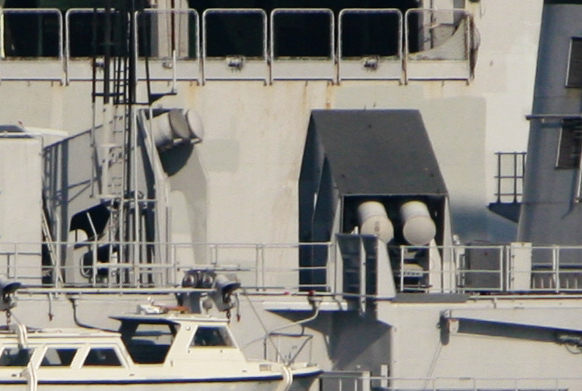
These MM38 (later MM40) Exocet SSM missiles were installed from the start, placed on two rows of three canisters angled, facing forward behind the bridge structure.
The was first deployed on warships from 1974. Range: 42 km.
⚙ specifications MM38 (1974) |
|
| Weight | 780 kg (1,720 lb) |
| Dimensions | 6 m (19 ft 8 in) x 34.8 cm (1 ft 1.7 in) wp 1.35 m (4 ft 5 in) |
| Propulsion | Solid propellant engine |
| Speed | Mach 0.93 or 1,148 km/h (713 mph; 620 kn) |
| Range | 40 km (25 mi; 22 nmi) |
| Guidance | Inertial, active radar homing, and GPS |
| Ceiling | |
| Accuracy | |
| Payload | 165 kg (364 lb) |
Crotale EDIR
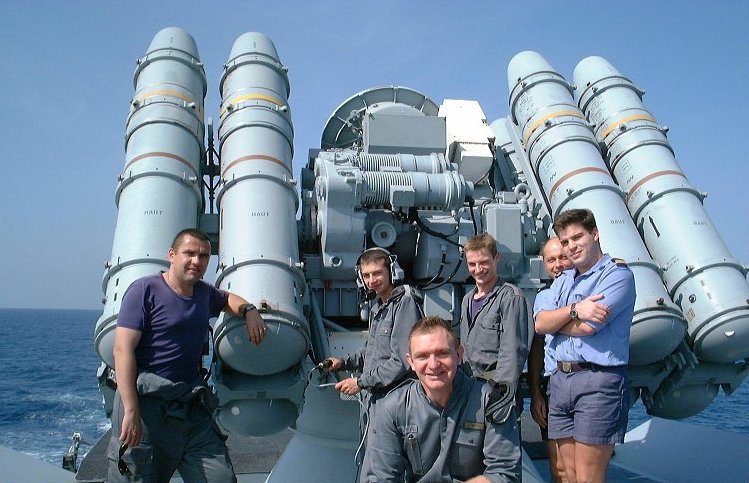
The Crotale EDIR SAM system (8-cells) was a small laucher short range AA and antimissile SAM installed aft, atop the hangar roof. Each launcher had eight canisters. This system, copied by many, incuding China started as a joint developement of Rockwell International and Thomson-Houston, plus Mistral in France for South Africa, under the Cactus project. It was later adopted by all branches of the French Armed Forces, including the navy. These were possibly replaced by the Crotale NG in the 1990s.
⚙ specifications R440 |
|
| Weight | VT-1: 76kg |
| Dimensions | 2.89 m x 15 cm x wp 54 cm |
| Propulsion | Lens 3 solid-fuel boost-glide |
| Speed | 800 m/s (Mach 2.3) |
| Range | 11 km |
| Guidance | Automatic command to line of sight, Canard and tail axis control |
| Ceiling | max 6,000 m |
| Payload | 15kg Forward-directed blast warhead or blast-fragmentation warhead (VT-1), infrared fuse |
Artillery: 2x 20mm
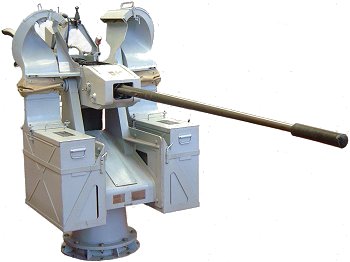 Later were added two GIAT 20F2 20mm machine guns in the superstructure amidship to defend against incoming close-in asymetric threats, and later completed by two 12.7 mm or cal.0.5 Browning HMGs for the same reason.
Later were added two GIAT 20F2 20mm machine guns in the superstructure amidship to defend against incoming close-in asymetric threats, and later completed by two 12.7 mm or cal.0.5 Browning HMGs for the same reason.
GIAT 20F2 20mm machine gun:
French weapon system long derived from the Swiss Oerlikon, this Gas unlocked, delayed blowback cannon was developed from the GIAT M693 in the 1980s, used by a large variety of French ships (nearly all) to this day.
Specs:
332 kg (732 lb), 2,600 mm (100 in) barrel 1,970 mm (78 in) elevation −15° to + 65°
Shell 20×139mm, 900 round/min, mv 1,050 m/s (3,400 ft/s) RA 1,500 m (4,900 ft) against aerial targets.
Torpedoes
L5 mod 4: The L5 Torpedo model 4 took advantage of 4x better sonar ranges and three models were developed, the Mod 4. was the upgraded last variant of the mode. They could operate at depths of 1,800 feet (550 m) if needed, and were powered by a Silver-zinc Battery to 10,000 yards for Mod.4 and carried a 440 lbs. (200 kg) HBX-3 or TNT warhead. It was also capable of engaging a surface target as well, but were primarily ASW weapons.
MU-90: This next-gen Italo-French lightweight torpedo was designe to outperfom the US Mark 54. It was introduced from 1993 in both navies. It weighted 304 kg (670 lb) for 2.85 m (112 in) in lenght and a diameter of 323.7 mm (12.74 in), powered by an electric Pump-jet and carrying a 32.7 kg PBX shaped charge warhead to blast through the pressure hull of their target.
Range went from 10 km (5.4 nmi) at 50 kn (93 km/h) to 23 km (12 nmi) at 29 kn+ (54 km/h) and dive under 1000 m.
Sensors

Racal-Decca DRBV-26 An air surveillance radar
Racal-Decca DRBV-15 A (or 51 C): Low altitude surface-to-air surveillance radar
Racal-Decca DRBN-32 E: Fire control radar
2x Racal-Decca DRBN-34 (or Kelvin-Hugues 1007) FCS radars
Active hull sonar 4110 CL:
DUBV-43C towed sonar:
2x ARBB-36 jammers:
ARBR-16 detector:
2 x Syllex or Dagaie Mk2 or Replica decoy projectors.
SLQ-25 Nixie towed noisemaker (See USN ships for reference)
2 x DIBC-2 A firing lines
DIBV-2 A VMB or Thales Vigy infrared monitoring system
SENIT 4 combat system with datalink 11
Syracuse and Inmarsat satellite transmission systems (Satcom)
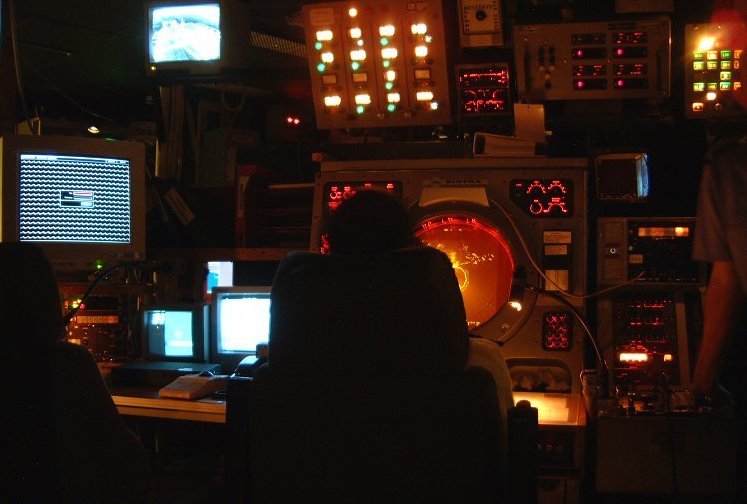
The PC NCO onboard Lamotte Picquet.
At the end of their career, D645 and 646 (Lamotte-Picquet and Latouche Treville) had two DRBN-32, DRBV-15A, DRBC-33A radars but also the Panda DMA-B, Piranha III IR E/O directors and the DUBV-24C, DUBV-43C VDS and DSBV-61A towed sonars. Elmevtron,ic warfare was generous, wuth several layers procured by the ARBR-17, ARBB-32B, ARBG-1A Saigon ECM suites as well as two AMBL-1C Dagaie Mk 2 decoy rocket launchers and two Replica floating radar decoys plud the USN classic SLQ-25A Nixie towed torpedo decoy as well as the SENIT-4 CCS for commnd and communication.
Air Group
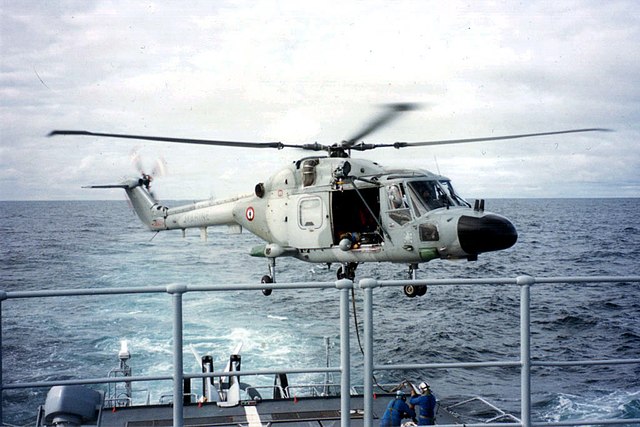
The Lynx is was redesigned to last until the end of service of these frighates, with Lynx No. 273 delivered in 2015 in the HAS.2 renovated by the AIA (Atelier Industriel de l’Aéronautique), carrying a civil and military GPS, HF/SSB radio (1000 nm range) encrypted L11 data link, ship identification system (AIS), aviation identification friend/foe (IFF) and autonomous distress beacon.
They soldiered on until 2022 when the last ship was retired. The Lynx Mk.4(FN) was an upgraded version for the Aéronavale, with Gem 42-1 engines and 14 built.
In short: Speed 175 knots (201 mph, 324 km/h), range 285 nmi (328 mi, 528 km) or 5h 20 min. Depth charges or 2x torpedoes.
The AS565 Panther was later used in alternative. This “pedro” used for SAR and plane guard on French carriers such as the Charles de Gaulle was also a decent ASW model, with the Long-Range Active Sonar (HELRAS) dipping sonar using seven projection elements and receiving array with eight extending arm to catch any submarine within a 500 meters underwater range. It was completed by a disc-shaped ASW array under the nose. It was also less fast at 300 kph, with a 4 hours endurance or 820 km.
Modernizations
First wave was in the 1990s, understandably since these vessels were in service already since the late 1970s. In 1996 Jean de Vienne and in 1999, Dupleix saw the removal of their 20mm/70 guns and of their now obsolete ARBB-32B ECM suite for the addition of two sextuple Sadral light SAM (39 Mistral) and two far more effective 30/70 OTOBreda-Mauser guns usable as CIWs. They were also fitted with the DIBV-2A Vampir IR E/O suite and had two new firing directors of the DIBC-2A E/O types plus two ARBB-36A ECM suites.
Georges Leygues, Dupleix and Montcalm all saw the replacement of their Crotale SAM by the new EDIR, and obsolete Syllex decoy launchers replaced by the AMBL-1C Dagaie Mk 2 decoy launchers.
In 1997-98, La Motte-Picquet, Primauguet and Latouche-Tréville received in turn two twin Simbad SAM and two ARBB-36 ECM suites.
In 1999, Georges Leygue and, La Motte-Picquet saw the removal of their helicopters, the hangar being converted into classroom, and also obtained two twin Simbad SAM instead of 20 mm autocannons.
In 2000 Montcalm had its Syllex decoy RL removed and sextuple Sadral SAM added (mistral short range missiles) as well as two 30mm/70 OTOBreda-Mauser and two DIBC-2A E/O directors plus ARBB-36 ECM suites and two AMBL-1C Dagaie Mk 2 decoy launchers.
By the early 2000s there was a second wave of modernization, with all seeing the replacement of their DRBN-32 for the DRBN-34 radar. Dupleix and Jean de Vienne saw the replacement of their DRBV-51C by a DRBV-15A radar, 60m bulges were installed with 210t concrete to reduced rolling and displacement took 330t. Gradually 12.7mm/90 heavy MG were added to deal with asymetric threats. The last to have their 20 mm gins removed were Primauguet, La Motte-Picquet, Latouche-Tréville, as well as their torpedo catapults, but their obtained in replacement 20mm/90 F2 autocannons and the new 324mm B515 TT MU-90 torpedoes (10 in stock). The last changes in 2007 was the new UMS-4110 sonar replacing the DUBV-23 on Montcalm and Jean de Vienne which in 2012 had their 30mm/70 repolaced by the 20mm/90 F2 CIWS.
The ACORES6 contract was notified by the DGA (French armament procurement agency) to upgrade analog sonars of Primauget, La Motte-Picquet and Latouche-Tréville frigates from the summer 2017. The signal received by the sonar went through digital processing, improving detection and identification capabilities with a new interface for display and quicker anti-torpedo warning capability.
The G. Leygues also tested drones, to be exact, the first automatic landings of a Camcopter S-100 was done on Montcalm for evaluation on October 9 and 10, 2008. The last two Georges Leygues class were decommissioned in 2020 and 2022 as the first units of the Aquitaine Class entered service in 2013 and the Navy hoped to maintained a derlivery rate of one every 12 months, and with the FREMM, replaced the two Suffren, two Tourville and all 7 Georges Leygues class. This is now a complete process. The new Aquitaine frigates are much more modular, digitalized, and stealthier than the Lafayette class, which are now undergoing their own modernization programme.

⚙ specifications |
|
| Displacement | 3,550 t (3,494 long tons), 4,500 t (4,429 long tons) full load |
| Dimensions | 139 x 14 x 5.7 m (456 ft x 45 ft 11 in x 18 ft 8 in) |
| Propulsion | CODOG 2× RR Olympus TM3B Gst 26,000 hp, 2× SEMT Pielstick 16PA6-V280 diesels 5,200 hp (3,878 kW) |
| Speed | 30 knots (56 km/h; 35 mph) |
| Range | 7,400 nmi (13,700 km; 8,500 mi) |
| Armament | 100 mm/55 M68, 2× 30 mm, Crotale EDIR, Simbad, MM38 Exocet, TTs L5 |
| EW Protection | ARBB-36, ARBR-16, Syllex/Dagaie Mk2/Replica CL, SLQ-25 Nixie, |
| Sensors | DRBV-26 A, DRBV-15 A, DRBN-32 E, DRBN-34, sonars 4110 CL, DUBV-43C, DIBC-2 A DIBV-2 A FCS |
| Navigation | SENIT 4, Syracuse, Inmarsat Satnav |
| Air Group | 2× Westland Lynx/AS565 Panther |
| Crew | 235 |
Career of the Leygues class
 Georges Leygues D-640 (1976)
Georges Leygues D-640 (1976)
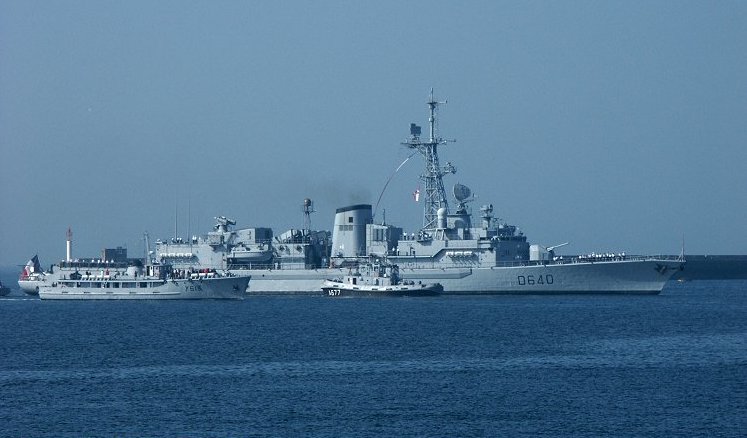
Georges Leygues was built at Arsenal de Brest, laid down on 16 September 1974, launched 17 December 1976 and completed on 10 December 1979. In 1981, she sortied with Guépratte as part of an Allied fleet training, detecting a Soviet submarine, which they chased for 19 hours and the Soviet submarine eventually started running at 28 kn (52 km/h; 32 mph) directly under the sonar of Georges Leygues before forced to surface. It was a Victor class, which many photos were taken by her on-board Lynx WG13.
When the Iranian ship Tabarzin was captured by a commando hostile to the regime in 1981 which sailed to France, she was escorted by G. Leygues.
In 1987, France and Iran broke off diplomatic relations, so Georges Leygues started escorting its own merchant vessels in the Persian Gulf. In 1992, she took part in Operation Restore Hope in Somalia. In 1999, she was partially converted as TS, her hangar converted to house student officers, and became a tendier for the old cruiser Jeanne d’Arc, multiplying training voyages of the French Naval Academy. She also intervened for humanitarian help after the catastrophic flooding in Mozambique.
In early 2004, she was sent to Haiti after the latest coup d’état, to assist in the French intervention. In December, Leygues and Jeanne d’Arc were sent to Indonesia after the 2004 earthquake. By 2011 she evacuated French nationals from civilians from Tunisia. She was decommissioned on 21 March 2014, and is now in long term reserve.
 Dupleix D-641 (1978)
Dupleix D-641 (1978)
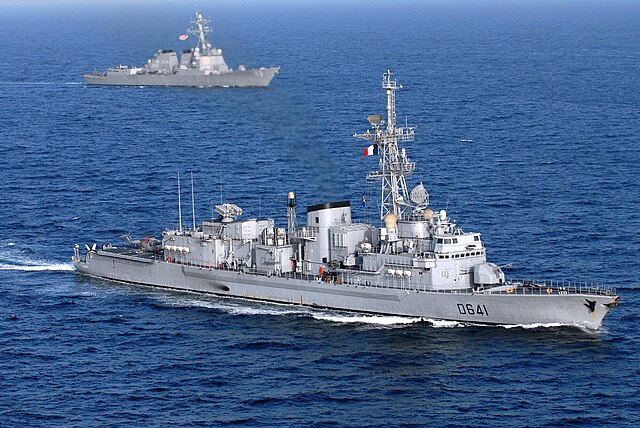
Dupleix was laid down on 17 October 1975 at the same yard (all were built in Brest), launched on 2 December 1978 anc completed on 13 June 1981. She was was named for Joseph François Dupleix, 18th century Governor of Pondichéry and Governor-General of India. She took part in the International embargo in the Gulf of Aqaba, Red Sea and Gulf of Aden from August 1990 to December 1990 (Gulf War).
She was the first French ship to have passed the Strait of Hormuz in October 1990, later visited by President François Mitterrand and MoD, JP Chevènement, FA Roland Dumas. In 2011 she took part in Operation Harmattan, the intervention in Libya. By November 13, 2013, she was modernized in Toulon and by April 14, 2014, while ordered to enter the Black Sea after the ennxation of Crimea, she was stopped in Cyprus. She was her last operational cruise by May 16, 2014. After her decommission in July 2015, she was placed in reserved at Toulon, in front of the Saint-Mandrier diving school as breakwater. She is still there, rusting away.
 Montcalm D 642 (1980)
Montcalm D 642 (1980)

FS Montcalm was laid down on 5 December 1975, launched 31 May 1980 and completed on 28 May 1982. She tooik partr in Operation Harmattan off Libya in 2011 and the Libyan Civil War, evacuating French and British citizens after fighting saw the airports closed. From 13 to 26 October 2014, she took part in exercise Catamaran 2014 of amphibious assault.
In 2002-2003 her hull had been reinforced by 60 m long bulkheads, ballasted with 210 t of concrete, reducing her range of 20%.
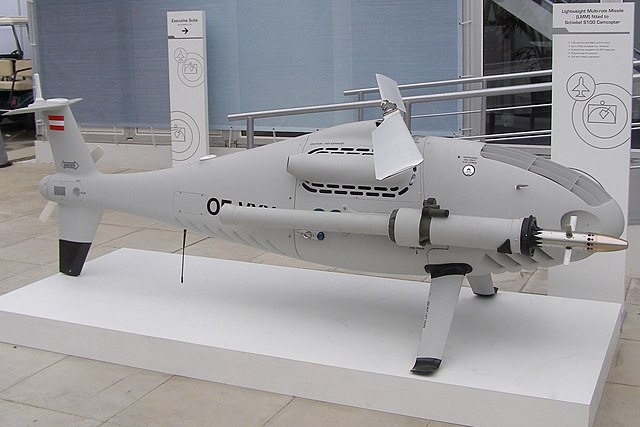
By 2008 she started testing the Camcopter S-100 drone manufactured by Schiebel, armed with a Lightweight Multi-role Missile. First automatic landings were successful so DCNS designed an Automatic Landing and Takeoff System (SADA) to precisely guide the drone during landing which was done with precision of 30 centimeters. The frigate was to be decommissioned in 2015 but after the sale of the FREMM Normandie to Egypt, she remained in service until July 3, 2017. He hull was stripped and she was sent to the Brégallion reserve. By the fall of 2023, she was to be scrapped by a coppany in Gironde at Bassens (Vinci group) with 7 other ships from Bregaillon and she left on April 2, 2024, now in srapping.
 Jean de Vienne D 643 (1981)
Jean de Vienne D 643 (1981)
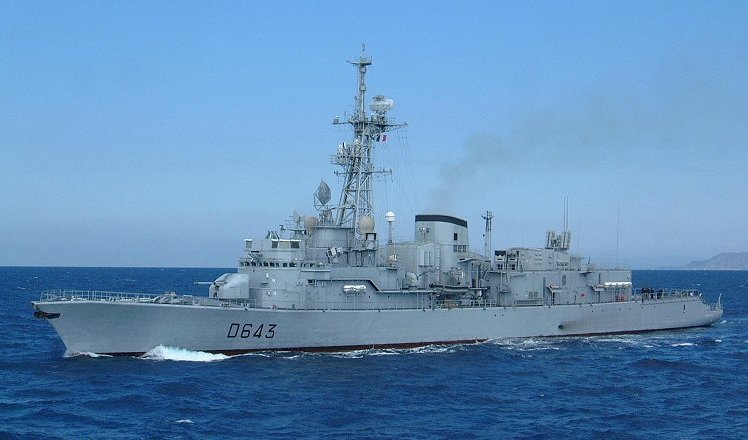
Jean de Vienne was laid down on 26 October 1979, launched 17 November 1981 and completed on 25 May 1984. She took part in the 1991 Gulf War, reported as the only French naval vessel part of the surface forces under operational command and control of the United States. In 2001, she took part in the task force for Opération Héraklès, the French contribution to the War in Afghanistan from the Indian Ocean. She escorted the aircraft carrier Charles de Gaulle.
On 4 January 2009, Jean de Vienne defended the Croatian tanker Donat and Panamanian-flagged cargo ship Vulturnus from Somalian pirates.
In 2011, she took part in Opération Harmattan, French operation within NATO’s military intervention in Libya.
The frigate was to be decommissioned in 2015 but after the sale of the FREMM Normandie to Egypt, its was postponed until July 2018, she stayed in service until June 11, 2018 or 9 January 2019 for hr official decommission. From 2019, she awaited dismantling in the port of Toulon; near Brégaillon cove. By the fhe fall of 2023 she was sold to Vinci for crapping at Gironde, Bassens and she was towed her in January 2024.
 Primauguet D 644 (1984)
Primauguet D 644 (1984)
Primauguet was laid down on 17 November 1981, launched on 17 March 1984 and completed on 5 November 1986. She was named after the 15th century captain Hervé de Portzmoguer. Her main roles has been The main roles escort of other ships (submarine, aircraft carrier, tanker, etc.), participating in the war against terrorism, against drugs trafficking, and occasional rescue at sea. Primauguet participated also in regular Franco-British cooperation exercise and joint exercises with NATO fleets, notably teamiong up with the the minehunter Cassiopeia. She served in many missiones around the world, and by January 2016, she took part in the rescue and evacuation of the ro-ro “Modern Express” off the Bay of Biscay, rescuing the crew with her a WG-13 Lynx helicopter and ensured to avoid possible collisions with other ships in the area and prepare towing.
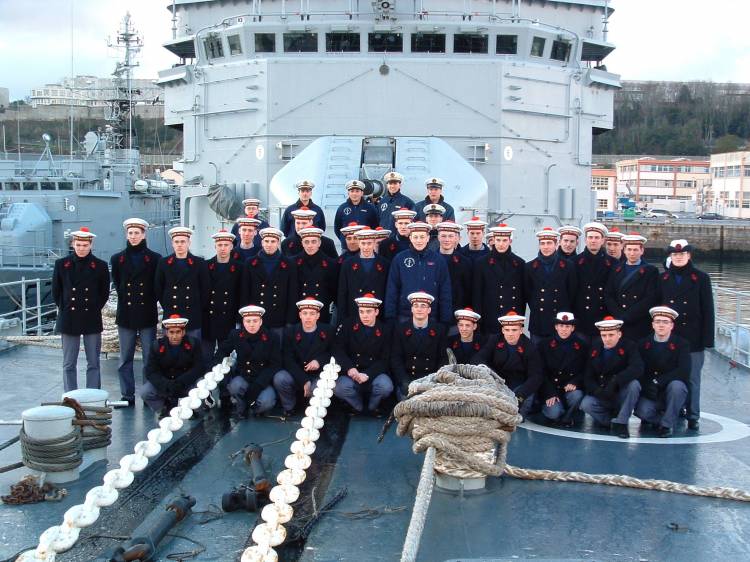
On January 7, 2019 she departed for her last three-month operational mission in the North Atlantic before withdrawal from service. She was decommissioned on 1 April 2019 and is today at Bassens near Bordeaux, awaiting scrapping.
 La Motte-Picquet D 645 (1985)
La Motte-Picquet D 645 (1985)
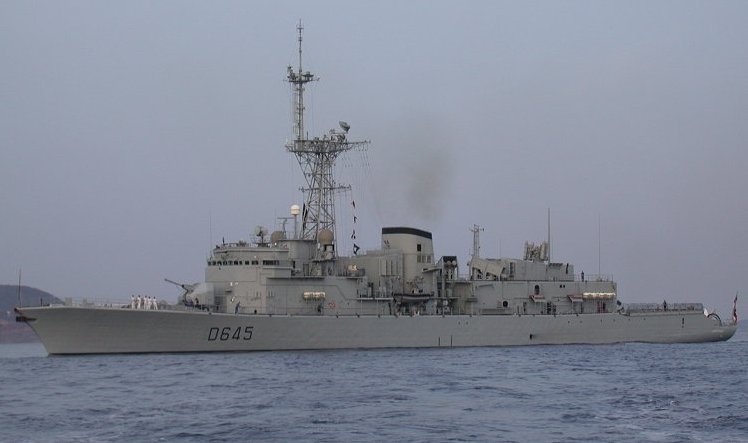
La Motte-Picquet was laid down on 12 February 1982, launched on 6 February 1985 and completed on 18 February 1988.
She was decommissioned on 13 October 2020. On 22 August 2007, she recatpured the Danish freighter “Danica White” after being captured by Somali pirates on 3 June.
She left Brest on 9 November 2011 for a tour of duty in the Indian Ocean, refuelled by USNS Patuxent on 10 January 2012. On 22 January she passed through the Straits of Hormuz and sailed wit the British frigate HMS Argyll and US battlegroup USS Abraham Lincoln for operations there. Later she took part in Opération Chammal, from November 2015, with the carrier Charles de Gaulle task force, launching strikes against the Islamic State of Iraq and Levant from January 2016. By March 2016, she shadowed the Russian destroyer Vice-Admiral Kulakov accompanied by an oiler and tugboat passing near French waters. In April 2016, she took part of Anglo-French CJEF exercise. She was decommissioned on 13 October 2020.
 Latouche-Tréville D 646 (1988)
Latouche-Tréville D 646 (1988)
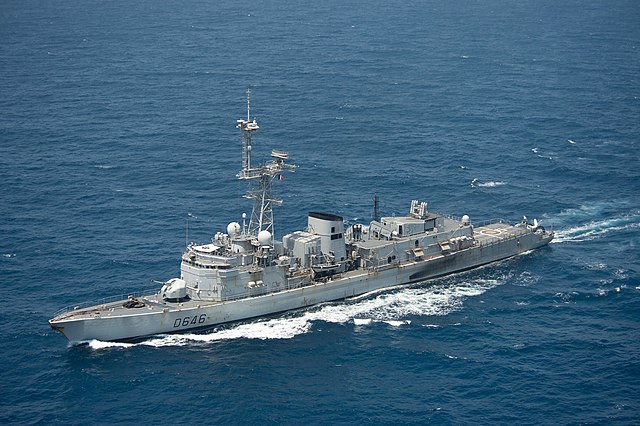
Latouche-Tréville was laid down on 15 February 1984, launched 19 March 1988 and completed on 16 July 1990. In November 2006 and June 2010, she visited London on diplomatic duties, moored alongside HMS Belfast. By mid 2009, she was filmed in stormy seas for a documentary. By late 2009, she was attached to an international NATO force for fleet exerises and visited Portsmouth Naval Base with Dutch, Norwegian, Spanish and Turkish ships. On 15 October 2012, she visited Leith Docks in Scotland.
On 18 April 2015, she escorted the 18th cent. replica frigate Hermione from La Rochelle, for her maiden voyage across the Atlantic to Yorktown in Virginia to commemorate the visit of Lafayette. Latouche-Tréville was back home on 10 August. In May she was part of a dozen ships and four submarines taking part in NATO “Dynamic Mongoose” exercise. Tensions with Russia had the exercise extended in the Norwegian waters and many anti-submarine warfare operations. By 4 June she stopped at Leith Docks. by 9 January 2020, she was damaged in a storm after departing Brest, returned for repairs agyer with her top mast went down with her electronic warfare pod and starboard SYRACUSE system. However it was planned indeed to have her retired, bu since Motte-Picquet was retired already she was reactivated and repaired. By March 2022 she took part in an exercise in the Baltic Sea for with NATO for a last deployment, bacl to to Brest in June 2022. She was decommissioned on 1 July. Now in reserve awaiting her fate.
Read More/Src
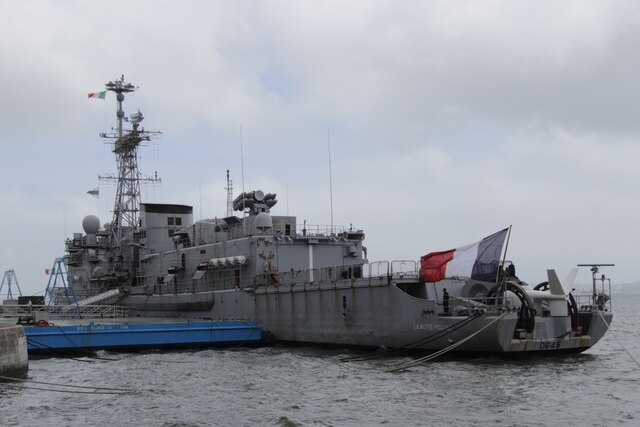
Lamotte Picquet in Ireland
Books
Michel Vergé-Franceschi (dir.), Dictionnaire d’Histoire maritime, Paris, éditions Robert Laffont, coll. « Bouquins », 2002
Jean Meyer et Martine Acerra, Histoire de la marine française : des origines à nos jours, Rennes, Ouest-France, 1994
Rémi Monaque, Une histoire de la marine de guerre française, Paris, éditions Perrin, 2016, 526 p.
Alain Boulaire, La Marine française : De la Royale de Richelieu aux missions d’aujourd’hui, Quimper, éditions Palantines, 2011
Links
battleships-cruisers.co.uk/
navypedia.org/
globalsecurity.org/
secretprojects.co.uk
seaforces.org/
armyrecognition.com/
en.wikipedia.org/
globalsecurity.org/
janes.com/
secretprojects.co.uk/
http://netmarine.net/
actunautique.com/
commons.wikimedia.org/
web.archive.org netmarine.net/ lamotte
Videos
Model Kits
Main query on scalemates
For once, Heller was absent for this class, only covered by l’Arsenal by now, at 1:400 scale.
3D
On 3dmodels.org

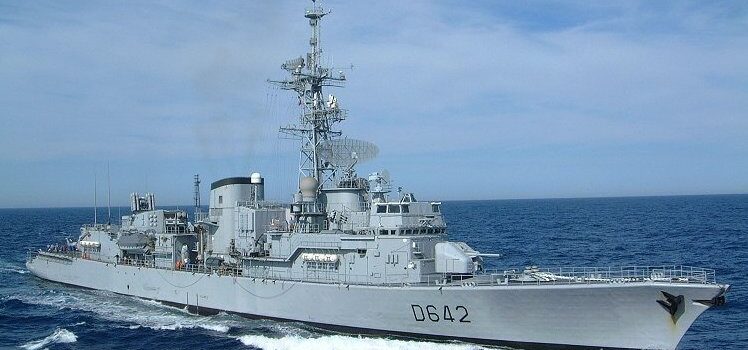
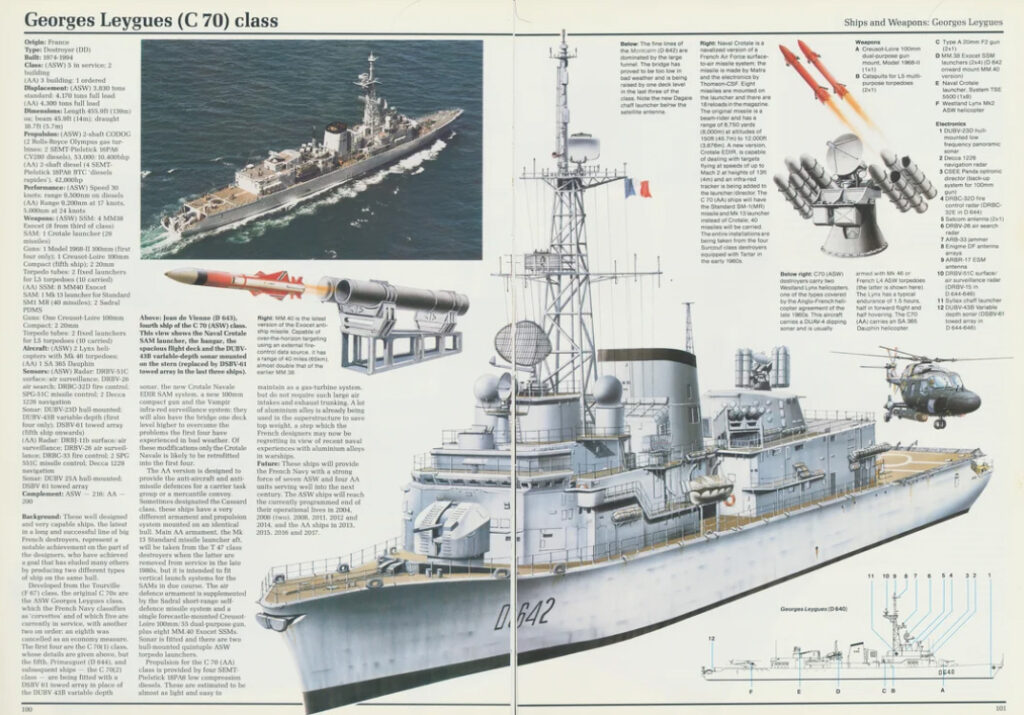
 Latest Facebook Entry -
Latest Facebook Entry -  X(Tweeter) Naval Encyclopedia's deck archive
X(Tweeter) Naval Encyclopedia's deck archive Instagram (@navalencyc)
Instagram (@navalencyc)





 French Navy
French Navy Royal Navy
Royal Navy Russian Navy
Russian Navy Armada Espanola
Armada Espanola Austrian Navy
Austrian Navy K.u.K. Kriegsmarine
K.u.K. Kriegsmarine Dansk Marine
Dansk Marine Nautiko Hellenon
Nautiko Hellenon Koninklije Marine 1870
Koninklije Marine 1870 Marinha do Brasil
Marinha do Brasil Osmanlı Donanması
Osmanlı Donanması Marina Do Peru
Marina Do Peru Marinha do Portugal
Marinha do Portugal Regia Marina 1870
Regia Marina 1870 Nihhon Kaigun 1870
Nihhon Kaigun 1870 Preußische Marine 1870
Preußische Marine 1870 Russkiy Flot 1870
Russkiy Flot 1870 Svenska marinen
Svenska marinen Søværnet
Søværnet Union Navy
Union Navy Confederate Navy
Confederate Navy Armada de Argentina
Armada de Argentina Imperial Chinese Navy
Imperial Chinese Navy Marinha do Portugal
Marinha do Portugal Mexico
Mexico Kaiserliche Marine
Kaiserliche Marine 1898 US Navy
1898 US Navy Sovietskiy Flot
Sovietskiy Flot Royal Canadian Navy
Royal Canadian Navy Royal Australian Navy
Royal Australian Navy RNZN Fleet
RNZN Fleet Chinese Navy 1937
Chinese Navy 1937 Kriegsmarine
Kriegsmarine Chilean Navy
Chilean Navy Danish Navy
Danish Navy Finnish Navy
Finnish Navy Hellenic Navy
Hellenic Navy Polish Navy
Polish Navy Romanian Navy
Romanian Navy Turkish Navy
Turkish Navy Royal Yugoslav Navy
Royal Yugoslav Navy Royal Thai Navy
Royal Thai Navy Minor Navies
Minor Navies Albania
Albania Austria
Austria Belgium
Belgium Columbia
Columbia Costa Rica
Costa Rica Cuba
Cuba Czechoslovakia
Czechoslovakia Dominican Republic
Dominican Republic Haiti
Haiti Hungary
Hungary Honduras
Honduras Estonia
Estonia Iceland
Iceland Eire
Eire Equador
Equador Iran
Iran Iraq
Iraq Latvia
Latvia Liberia
Liberia Lithuania
Lithuania Mandchukuo
Mandchukuo Morocco
Morocco Nicaragua
Nicaragua Persia
Persia San Salvador
San Salvador Sarawak
Sarawak Uruguay
Uruguay Venezuela
Venezuela Zanzibar
Zanzibar Warsaw Pact Navies
Warsaw Pact Navies Bulgaria
Bulgaria Hungary
Hungary

 Bundesmarine
Bundesmarine Dutch Navy
Dutch Navy Hellenic Navy
Hellenic Navy Marina Militare
Marina Militare Yugoslav Navy
Yugoslav Navy Chinese Navy
Chinese Navy Indian Navy
Indian Navy Indonesian Navy
Indonesian Navy JMSDF
JMSDF North Korean Navy
North Korean Navy Pakistani Navy
Pakistani Navy Philippines Navy
Philippines Navy ROKN
ROKN Rep. of Singapore Navy
Rep. of Singapore Navy Taiwanese Navy
Taiwanese Navy IDF Navy
IDF Navy Saudi Navy
Saudi Navy Royal New Zealand Navy
Royal New Zealand Navy Egyptian Navy
Egyptian Navy South African Navy
South African Navy






























 Ukrainian Navy
Ukrainian Navy dbodesign
dbodesign